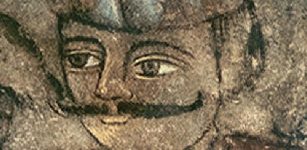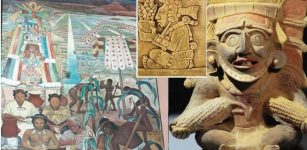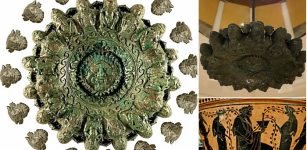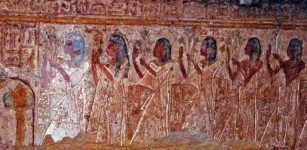War Between Romans And Persians Lasted 721 Years: One Of The World’s Longest Human Conflicts In History
Ellen Lloyd - AncientPages.com - One of the world’s longest human conflicts in history was between the Romans and Persians.
The Hundred Years’ War and even Rome’s long and epic struggle with Carthage was brief compared to Rome and Persia’s Near Eastern struggle. The wars between these great empires lasted about 721 years.
At the beginning of the ancient Roman Empire, the conflicts were only of territorial nature. Ancient Romans used aggressive methods to expand the boundaries of their territories. Later, there came to be a religious aspect to the wars as the Eastern Realm of Christendom confronted the Western bounds of Persian Zoroastrianism.
Tagh-e Kasra as it looked in 1934 in the ancient city of Ctesiphon. Credit: Public Domain
The ancient Roman Empire stretched from Syria to Britain. Only one power could challenge Roman arms on anything approaching an equal footing: the Persian rulers of the land that now comprises Iraq. This area, the location of numerous ancient civilizations, was the heart of a Persian empire stretching from modern Pakistan to the Syrian border. Two dynasties ruled the Persian Empire, the Parthians (238 B.C.–A.D. 227) and later the Sassanids (A.D. 227-651).
Persians had established the capital city of Ctesiphon thirty-five miles from the site of modern Baghdad. As they became great empires during the following centuries, Rome and Persia fought many wars. The Romans attacked Ctesiphon more than a half-dozen times, and on five occasions in the second and third centuries A.D., they took the city by storm.
Roman victories in Iraq were transitory and self-defeating.
Modern reconstruction of Punic Carthage. The circular harbor at the front is the Cothon, the military port of Carthage, where all of Carthage's warships (Biremes) were anchored. Damian Entwistle - CC BY-SA 2.0
Julius Caesar’s planned invasion of Iran through Armenia was cut short by his assassination on the Ides of March in 44 B.C. Mark Antony carried out Caesar’s invasion plan in 36 B.C., without the great military leader’s tactical skill. He lost half his men in the mountains of northwest Iran and marched home through Armenia in the harsh winter.
Emperor Trajan invaded Armenia and Mesopotamia between 114 and 115 and annexed them as Roman provinces. Before sailing downriver to the Persian Gulf, he captured the Parthian capital, Ctesiphon.
Being too old to fight, he later withdrew his armies and returned to Syria. Emperor Trajan died in 117.
".... Drawing on a wealth of new research, archaeologist, historian, and master storyteller Richard Miles resurrects the civilization that ancient Rome struggled so mightily to expunge. This monumental work charts the entirety of Carthage's history, from its origins among the Phoenician settlements of Lebanon to its apotheosis as a Mediterranean empire whose epic land-and-sea clash with Rome made a legend of Hannibal and shaped the course of Western history. Carthage Must Be Destroyed reintroduces readers to the ancient glory of a lost people and their generations-long struggle against an implacable enemy. ..." Read more
The struggles continued between the empires. Finally, a Persian hero arose in the person of Shapur I, the second king of the Sassanid dynasty, whose reign of 241-272. He retook much of the territory Rome had won in previous wars and even made incursions into Roman territory.
He captured Roman Emperor Valerian after crushing his army in A.D. 260, and Khusro II in 611 penetrated the Bosporus, in sight of Constantinople before a Byzantine counterattack drove him and his men back to Iraq. The Sassanid state collapsed not long after the Arab victory at the Battle of Qadesiya in Iraq in 637. Byzantium survived but only after losing Syria, Egypt, Palestine, and northern Africa to the Arabs.
Roman emperor Valerian surrenders to Shapur I. Credit: Ali Ganjei - Public Domain
The conflict between the great empires was a matter of power and glory. For centuries, every ambitious young Roman dreamed of winning a battle and returning home to celebrate a triumph.
A triumph was not merely a victory parade, although the successful general–in a chariot pulled by white horses and with a laurel wreath on his head–would ride through the city of Rome to the cheers of the crowd, accompanied by his troops and with booty and captives on display.
The ostentatious parade was an official recognition by the Roman Senate that the general had won a major victory and that, in effect, he was a man to be reckoned with. For many a Roman noble, the triumphal procession led to the Forum, where political success began.
The devastating effects of these wars were that both empires crippled. Persia was plunged into several years of dynastic turmoil and civil war.
Credit: Adobe Stock - vukkostic
The Roman Empire was also severely affected, with its financial reserves exhausted by the war and the Balkans now largely in the hands of the Slavs.
So, which side won the battle? None, actually. The winners of the conflict between the Romans and Persians were the Arabs. Within a few years, both once great empires were struck by the onslaught of the Arabs who inherited the energy that the two powers wasted on the conflict.
Rarely in the history of human conflict has a feud such as the one between the empires of Rome and Persia lasted so long and accomplished so little.
Written by Ellen Lloyd - AncientPages.com
Copyright © AncientPages.com All rights reserved. This material may not be published, broadcast, rewritten or redistributed in whole or part without the express written permission of AncientPages.com
More From Ancient Pages
-
 On This Day In History: Vlad II Known As Vlad Dracul (‘Vlad The Dragon’) Was Born – On August 30, 1400
News | Aug 30, 2016
On This Day In History: Vlad II Known As Vlad Dracul (‘Vlad The Dragon’) Was Born – On August 30, 1400
News | Aug 30, 2016 -
 Medusa – Cursed By Athena And Killed By Perseus
Featured Stories | Jul 30, 2018
Medusa – Cursed By Athena And Killed By Perseus
Featured Stories | Jul 30, 2018 -
 Ancient Disc-Shaped Copper Ingots Found In Shipwreck At Bulgaria’s Sea Coast
Archaeology | Apr 28, 2020
Ancient Disc-Shaped Copper Ingots Found In Shipwreck At Bulgaria’s Sea Coast
Archaeology | Apr 28, 2020 -
 On This Day In History: Magellan’s Expedition Circumnavigates Globe – On Sep 6, 1522
News | Sep 6, 2016
On This Day In History: Magellan’s Expedition Circumnavigates Globe – On Sep 6, 1522
News | Sep 6, 2016 -
 LIDAR Advanced Technology Spotted Rare Pre-Columbian Florida Village – Highly-Prized Producer Of Beads
Archaeology | Nov 10, 2019
LIDAR Advanced Technology Spotted Rare Pre-Columbian Florida Village – Highly-Prized Producer Of Beads
Archaeology | Nov 10, 2019 -
 Yum Kaax, Mayan God Of Agriculture, Lord Of Woods And Caretaker Of Animals
Featured Stories | Jul 15, 2020
Yum Kaax, Mayan God Of Agriculture, Lord Of Woods And Caretaker Of Animals
Featured Stories | Jul 15, 2020 -
 Ancient Roman Government Structure And The Twelve Tables
Civilizations | Jan 18, 2016
Ancient Roman Government Structure And The Twelve Tables
Civilizations | Jan 18, 2016 -
 On This Day In History: Joan Of Arc Was Captured By The Burgundians – On May 23, 1430
News | May 23, 2016
On This Day In History: Joan Of Arc Was Captured By The Burgundians – On May 23, 1430
News | May 23, 2016 -
 Last Of The Giant Camels And Archaic Humans Lived Together In Mongolia Until 27,000 Years Ago
Fossils | Mar 24, 2022
Last Of The Giant Camels And Archaic Humans Lived Together In Mongolia Until 27,000 Years Ago
Fossils | Mar 24, 2022 -
 3D Scans Used To Study Mysterious Roman Burial Practice
Archaeology | Jun 5, 2023
3D Scans Used To Study Mysterious Roman Burial Practice
Archaeology | Jun 5, 2023 -
 Etruscan Beautiful Bronze Lamp of Cortona – Studied
Artifacts | Apr 10, 2024
Etruscan Beautiful Bronze Lamp of Cortona – Studied
Artifacts | Apr 10, 2024 -
 Harappan Civilization Built Massive Protection Walls Against Tsunami 5,000 Years Ago
Archaeology | Jan 10, 2017
Harappan Civilization Built Massive Protection Walls Against Tsunami 5,000 Years Ago
Archaeology | Jan 10, 2017 -
 Ancient Footprints Offer Evidence Humans Wore Shoes 150,000 Years Ago – Scientists Say
Archaeology | Sep 11, 2023
Ancient Footprints Offer Evidence Humans Wore Shoes 150,000 Years Ago – Scientists Say
Archaeology | Sep 11, 2023 -
 Ranikot Fort: Gigantic Great Wall Of Pakistan Shows Greatness Of Indus Valley Civilization
Featured Stories | Mar 27, 2019
Ranikot Fort: Gigantic Great Wall Of Pakistan Shows Greatness Of Indus Valley Civilization
Featured Stories | Mar 27, 2019 -
 New Attempt To Solve The Easter Island Mystery – What Did Rapa Nui Look Like Before Europeans Arrived?
Archaeology | Sep 20, 2017
New Attempt To Solve The Easter Island Mystery – What Did Rapa Nui Look Like Before Europeans Arrived?
Archaeology | Sep 20, 2017 -
 Hazelnuts -‘Time Capsule’ To Reconstruct Landscape Of Ancient Forests In Sweden
Archaeology | Mar 5, 2024
Hazelnuts -‘Time Capsule’ To Reconstruct Landscape Of Ancient Forests In Sweden
Archaeology | Mar 5, 2024 -
 Amrita: Potion Of Immortality Consumed By Gods To Make Them Strong And Immortal
Featured Stories | Apr 5, 2019
Amrita: Potion Of Immortality Consumed By Gods To Make Them Strong And Immortal
Featured Stories | Apr 5, 2019 -
 What Female Jobs Could Lead To Being Accused Of Witchcraft In Early Modern England?
News | Sep 20, 2023
What Female Jobs Could Lead To Being Accused Of Witchcraft In Early Modern England?
News | Sep 20, 2023 -
 Secret Ancient Knowledge Of The Druids And The Mystery Of The Missing Library Of Iona
Artifacts | Sep 4, 2016
Secret Ancient Knowledge Of The Druids And The Mystery Of The Missing Library Of Iona
Artifacts | Sep 4, 2016 -
 Rock-Cut Tomb Of Pennut, Viceroy Of Nubia Under Reign Of Ramses VI
Civilizations | Dec 7, 2018
Rock-Cut Tomb Of Pennut, Viceroy Of Nubia Under Reign Of Ramses VI
Civilizations | Dec 7, 2018





